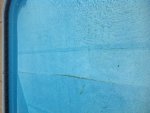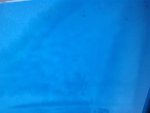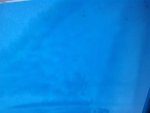Then this isn't algae. While it's possible it's something actually living and growing, I think with all the chemicals that were thrown into the pool several of which are incompatible with each other could be coagulating/precipitating onto the liner or it could be scale.
You must have lowered your pH a lot before doing the SLAM since I would have expected the pH to be quite a bit higher. Of course, the pH test isn't valid at high FC, but usually it will read falsely high, not low so that is strange. Also, with your very high CH, is it possible that you are getting calcium carbonate scale? Doing a SLAM will raise the pH so with a higher pH and the high CH you have you could get scaling. What does this stuff stuck to the liner feel like? Is it stuck to the liner so that it does not brush away? If so, then it sure sounds like scale to me.
If it is calcium carbonate scale, then I'd stop the SLAM, let the FC drop to normal levels, then retest the pH and lower it and see if the scale (if that's what it is) starts to dissolve.
It feels normal, the algae or whatever it is floats above the liner about 1/2"-3/4". It looks like sand actually today and is getting thicker.




